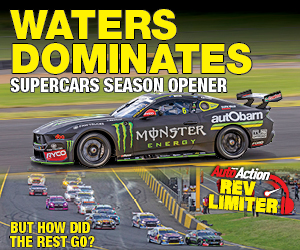UNDER THE SKIN: INTELLIGENT, BY DESIGN – PORSCHE 911 GT3 R

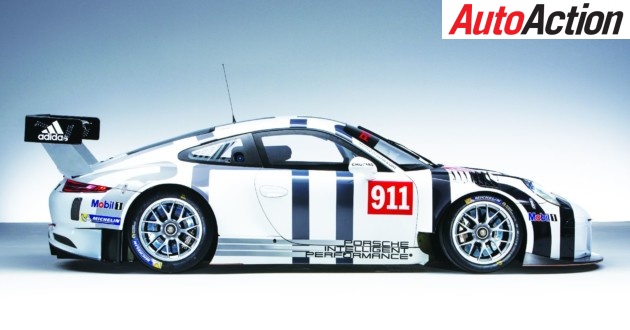
Porsche’s current GT3 challenger the 911 GT3 R (991)
Porsche’s 911 GT3 R is as close to a road car as you will find in GT3 racing. Or, should it be the other way around?
By PHIL BRANAGAN
IF YOU ever needed any reassurance that Porsche’s racers are more closely related to their road car forebears than any other carmaker, I present to you this snippet of information.
The company’s current GT3 racecar is based on the 2016 Porsche 911 GT3 RS which, nominally at least, is a road car – and which comes with a console-mounted, programmable Pit Speed limiter.
It comes with a 1mm thick magnesium roof panel, for Porsche claims a weight saving of approximately 800 grams. It has a carbon fibre bonnet, engine lid and front guards. The doors are fitted with lightweight glass, and are themselves equipped with pulls. There is no radio, no aircon.
The common barometer of speed is how fast it laps the Nurburgring; the Porsche manages the task in 7m20s, around 13s quicker than the 997 GT3 RS.
Reminder; we are still talking about the road car here…
The seventh generation 911 carries on a long tradition of racing excellence, and its road car cousins are very closely related
It was May 2015 when Porsche unleashed the R on an unsuspecting world. Actually there was not a lot of ‘unsuspecting’ going on; the GT3 had been around since 1999, based on the 996 model, and there had been four generations in the meantime, with new cars in 2004, 2006, 2009 and 2011. The first GT3 version of the 991 came in 2013, the GT3.
Based on the then-new roadgoing ‘991’, the new car carried over the technology introduced on the 911 GT3 RS, which meant while the flat-six engine has a similar capacity at 4.0-litres, there were many new things to admire. Like the 991, the racer had a new direct fuel injection, capable of delivering the fuel/air mixture at 200 bar of pressure, with dry sump lubrication, and producing, according to Porsche, ‘at least’ 500 horsepower.
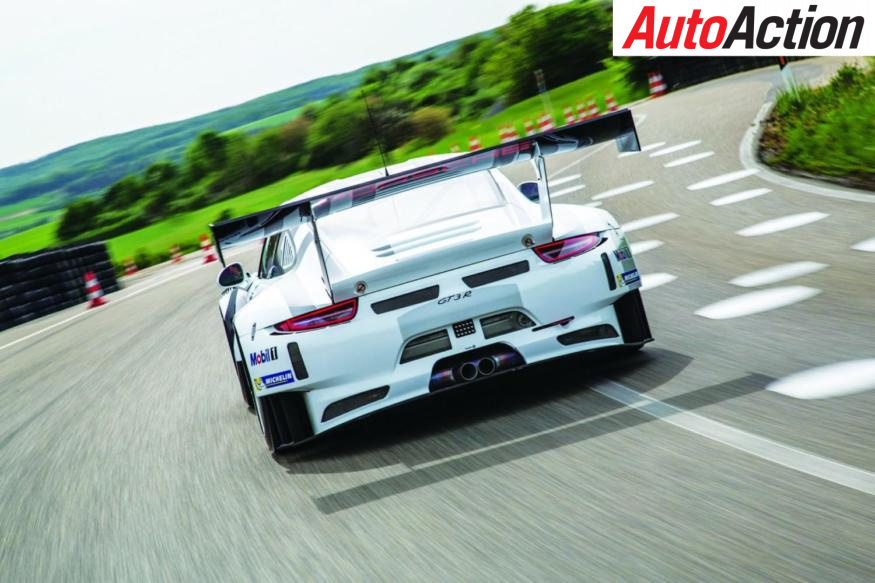
Porsche’s 911 GT3 R
Porsche’s Head of Motorsport Dr Frank-Steffen Walliser explained the philosophy behind the car’s design.
“The transfer of technology is important and Porsche is one of the few sports car manufacturers that doesn’t do this for marketing reasons,” he said. “Motorsport is an essential driving force behind new technologies.
“An example: We contest GT racing with restrictors, in other words the air intake of the engines is restricted. If I want a lot of power this can only be achieved through reducing internal friction and a high level of efficiency. We’ve gained a lot of experience over recent years, especially with the normally aspirated engine, and you notice this one-to-one with our road-going engine.
“Because it’s the very same employees who build the road-going and race vehicles, a kind of natural technology transfer takes place. The colleagues do not forget what they did on the race car, but carry this know-how over to the street car and try out things they believe might also work.”
So the racing-improves-the-breed equation works both ways.
“The technology transfer always flows in both directions,” Walliser continued. “This, for instance, is how direct fuel injection from our current engine generation was taken from production and applied in motor racing. Up until that point we’d only used intake manifold injectors. In the 911 GT3 R, we use the direct fuel injection that was first introduced in the boxer engines of the 911 GT3 road-going cars. From this we are hoping for advantages with efficiency.”
In the ‘both ways philosophy, the production car’s wheelbase is longer than on the previous generation, up 83mm to 2463mm – a decision made not to make a better road car but a better track car. The longer wheelbase aids handling, and the new car has better aero for greater downforce front and rear.
There, the similarities started to diverge. In the racer the roll cage is welded-in; there are built-in airjacks. Up front, the fuel tank is bigger, up to 120 litres from 108 on the older model racer (the road version makes do with 68). All the windows are clear polycarbonate and the steering – like the road car – was electrically, rather than hydraulically, assisted.
The aforementioned CF roof panel incorporates an escape hatch, as per regulations. Heavier again but this is a racing car, not a road car…
Braking is predictably impressive, with the car running 380mm front rotors and 372mm at the rear. Both are ventilated and grooved, and the six-piston callipers up front are machined from a solid block. The road car can be fitted with optional carbon-ceramic versions, provided you have a spare $20,000…
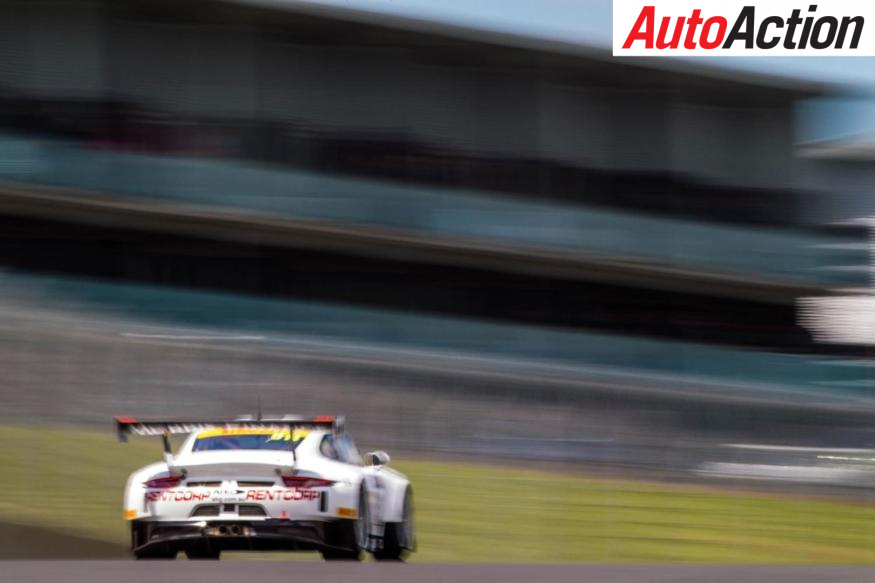
Walkinshaw Racing’s Porsche 911 GT3 R on track
On the local front, Walkinshaw Racing took delivery of its first car in April and raced it for the first time at Barbagallo Raceway in May.
WR’s Matt Nilsson has had vast experience with V8 Supercars but came to grips with the ‘customer’ car quickly.
“The biggest change in mindset for us was that it is effectively a control car,” said ‘Techo’, “everything’s homologated, there’s no development. It’s just about becoming a racer; where you just understand the car. From a development point of view, you learn how the thing responds to changes, you’re not looking for the next big development item, as such.
“You just have to go back to general race engineering, learning what the driver likes and what the level of adjustment is in the car. You get given a very good package, and it’s really just understanding that.
“It is a bit of a different mindset from that perspective, a different way of going racing. It’s more relaxed racing, if that makes sense. Australian GT is a good category that’s based around the gentleman racer and it’s a bit more casual but the level of competition is still high but it’s probably a bit more enjoyable that it’s more relaxed. That’s not to say there’s no stress level, still plenty of workload.”
There is no one-size-fits-philosophy when it comes to adapting to a GT car and in that regard, the Porsche is quite particular.
“Obviously the Porsche is very specific the way it handles relative to an Audi,” says Nilsson, “so a lot of it was understanding the strengths and weaknesses to the other manufacturers, because of the BOP [Balance of Performance]. Everyone has there own strengths and weaknesses and we have to make sure we maintain and maximise what our strengths were and make do with the other stuff as best you could because there’s some stuff that you just couldn’t do anything about.
“This year’s going to be a challenge again because we go to Bathurst with a different compound, or two compounds, and then the different construction and then the flow and effect that that has. But I guess the advantage for us in the GT Series this year is that the Bathurst hard tyre becomes our category tyre. The process will start at Bathurst and will carry through into the season and we did some evaluation the other day on understanding what it did to the car so we know where we have to start working from.”
And help, when is needed, is only as far away as Porsche’s Motorsport department.
“They’ve been great. Effectively we’re a customer team, in terms of the support you get. I have an engineer I can contact any time and she’s very good at coming back to you with a response, and if research is required. They’re very good with updates to the car in terms of whether its regularity or safety or reliability, you have a portal where you can directly get information from and ability to supply parts. I think it has been really, really good. They’ve been really good to work with.
“Porsche Australia and Porsche Centre Melbourne, their support to us has been fantastic throughout the program and we got some great contacts and support in doing what we do and it has been good to work with a new manufacturer from that perspective.”
The Porsche may not be the car most suited to Bathurst – but its pedigree is such that a victory is not out of reach. And, a lot of people will be watching…
BEHIND THE WHEEL

John Martin on the podium at Hampton Downs
On the face of it, one racing Porsche is much like another.
They are all 911s, sort of, and the performance and braking is something that is beyond the level of the road car – so it is just a matter of getting used to, by how far, surely?
Not so, according to John Martin, who has transitioned from the Carrera Cup 911 to the GT3 R.
“Driving a GT3R compared to a Cup Car is halfway house, it has quite a bit of aero, it has reasonable power and it’s got good grip.
“When I first started doing the Cup Car stuff I struggled initially, and a bit of it was me trying to make the car do what I wanted it to do, but compared to prototype and open-wheeler stuff the cars feel quite numb really. They don’t react to even small little things and you have to be very, very patient as well, which is probably not one of my strong suits.”
One of the biggest differences Martin has had to learn is how much driver assistance the GT3 R has.
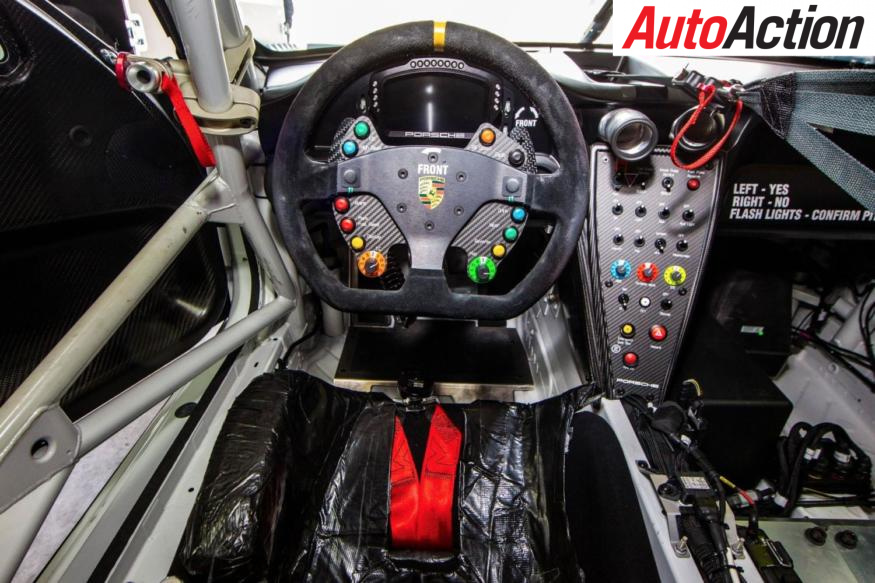
Behind the wheel of the Porsche 911 GT3 R
“A Cup Car has nothing, but this thing has 12 different positions of ABS in wet and 12 different positions in dry conditions and the Traction Control is exactly the same, 10 in dry, 10 in wet, which when you’ve driven it a little bit you tend to forget, or we seem to.
“We run the TC as minimal as possible, we run it on one and then the ABS as well is just on the minimal setting, if I could go even less again then it would be good, but we don’t have the option to.
“All that stuff, if anything, helps you out its just harder when you go back to something with no ABS. The TC stuff, you still have to manage the wheel spin anyway and the fastest way, I reckon, is to just have the TC as a safety net but you still drive it yourself. The prototype stuff that I have run before had Traction Control and they had developed their own stuff so I have done a lot of stuff with TC as well as developing a system for traction control. It’s cool to have that experience as I learnt a lot over the two years I was developing it. Whereas this no development it’s just the settings you have to play with and that’s it.”
And while he has been ‘learning’ the car, there have been changes along the way.
“From where it rolled out of the box it’s quite different now. We have had a bit of help from the factory, but they’ve run the car initially really soft and we couldn’t get on with that. So with what the cars homologated, the spring packages, we are towards the upper end of the stiff side. It worked a lot better for us in feel and better for lap time as well. It was a win-win. Other people like Duvashen [Padayachee], who had driven it a couple of times, Liam’s [Talbot] driven a couple of times and we’ve had a few other people in it and they have said the same thing, so at least it’s just not me.
“In other categories I have had some weird set-ups that suit me but don’t work for anyone else but since everyone has to drive it, the whole endurance racing is all a bit of a compromise.
CHANGE IS COMIN’
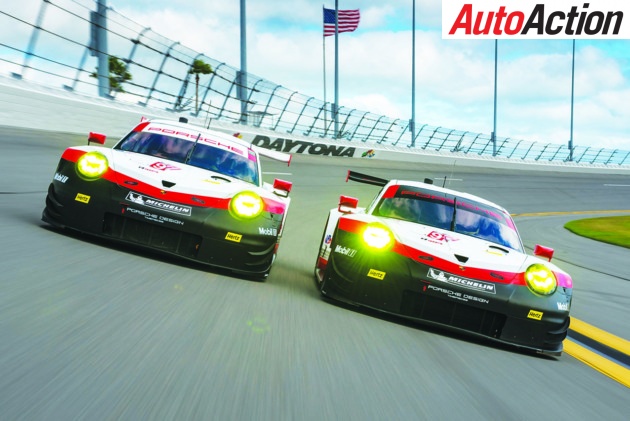
Porsche’s 911 GT3 RSR at Daytona
The Porsche 911 has been one of the staples of international racing for generations – but the GT3 R could be the last of the breed.
Ever since the Moses Motorsport entry lined up for the 24 Hours of Egypt, 911s have had their engines in the boot, challenging Porsche’s engineers to bend the rules of physics to get the car to go around corners. The results speak for themselves.
Now, there has been a change. The GT3 R competes around the world and, in the IMSA Series, in the GTD category, mainly in the hands of customer teams. But the GTLM class is a no-holds barred contest between works or works-assisted teams, where Porsche faces fierce opposition, in the form of Ford’s GT and Chevrolet’s Corvette C7.R, along with Ferrari and BMW.
Porsche’s new 911 RSR is mid-engined, with the motor where engineers would like it to be, and that has meant a massive redesign for the car. The rear window is now designed to funnel air into a large intake, which has prompted a major redesign for the car’s aero.
The proof of the pudding will be in the racing and that starts next week at Daytona. The new Porsche was only half a second behind the dominant Fords in the traditional Roar Before the 24 test session last week.
Meanwhile the 911 GT3 R will race in the more traditional GTD class.
Will the next version of that car be mid-engined? Porsche is not saying – yet.
Technical Specifications Porsche 911 GT3 R (991)

Porsche’s 911 GT3 R on track
Engine
Water-cooled six-cylinder boxer engine (rear mounted)
Bore 102mm x stroke 81.5mm (4000cc)
Output: over 368kW (500hp) subject to FIA BoP (air restrictor)
Direct fuel injection
Dry sump lubrication
Transmission
Porsche sequential six-speed constant-mesh gearbox with paddle shift
Mechanical slip differential
Bodyshell
Lightweight body featuring intelligent aluminium-steel composite design
Integrated (welded) roll-cage according to FIA Appendix J
Removable escape hatch in roof
Lightweight exterior design: carbon fibre reinforced plastic doors, rear cover, rear wing, wheel arches, front and rear fairing
Polycarbonate glazing
Removable polycarbonate door windows
FT3 safety fuel cell, approx. 120 litres, with fuel cut off safety valve in accordance with FIA regulations
Suspension
Front
McPherson strut, adjustable in height, camber and toe
Adjustable anti-roll bar blades (left and right)
Power-assisted steering with electro-hydraulic pressure feed
Rear
Multilink independent rear suspension, adjustable in height, camber, toe
Adjustable anti-roll bar blades (left and right)
Brake system
Two separate brake circuits for front and rear axles; adjustable by driver via brake balance bar system
Front
Six-piston aluminium monobloc racing brake calliper
Ventilated and grooved 380mm steel brake disc, aluminium disc bell
Rear
Four-piston aluminium monobloc racing brake calliper
Ventilated and grooved 372mm steel brake disc, aluminium disc bell
Wheels/tyres
One-piece BBS alloy wheels, on centre-lock hubs and single wheel nuts
Front 300/650-18 13J x 18 offset
Rear 310/710-18 12.0J x 18 offset
Electrics
Cosworth power module IPS32
Race ABS
Traction control
Weight/dimensions
Weight: 1220kg (subject to BoP)
Length 4604 mm
Wheelbase: 2463 mm
Track F 1975mm/R 2002mm
Price
429,000 Euros (A$610,000)
(Road car $387,300 plus on-roads)
After Auto Action’s latest Under the Skin feature? Pick up the latest copy of magazine, in stores Thursday. Also follow us on social media Facebook, Twitter and Instagram for all the latest news.


